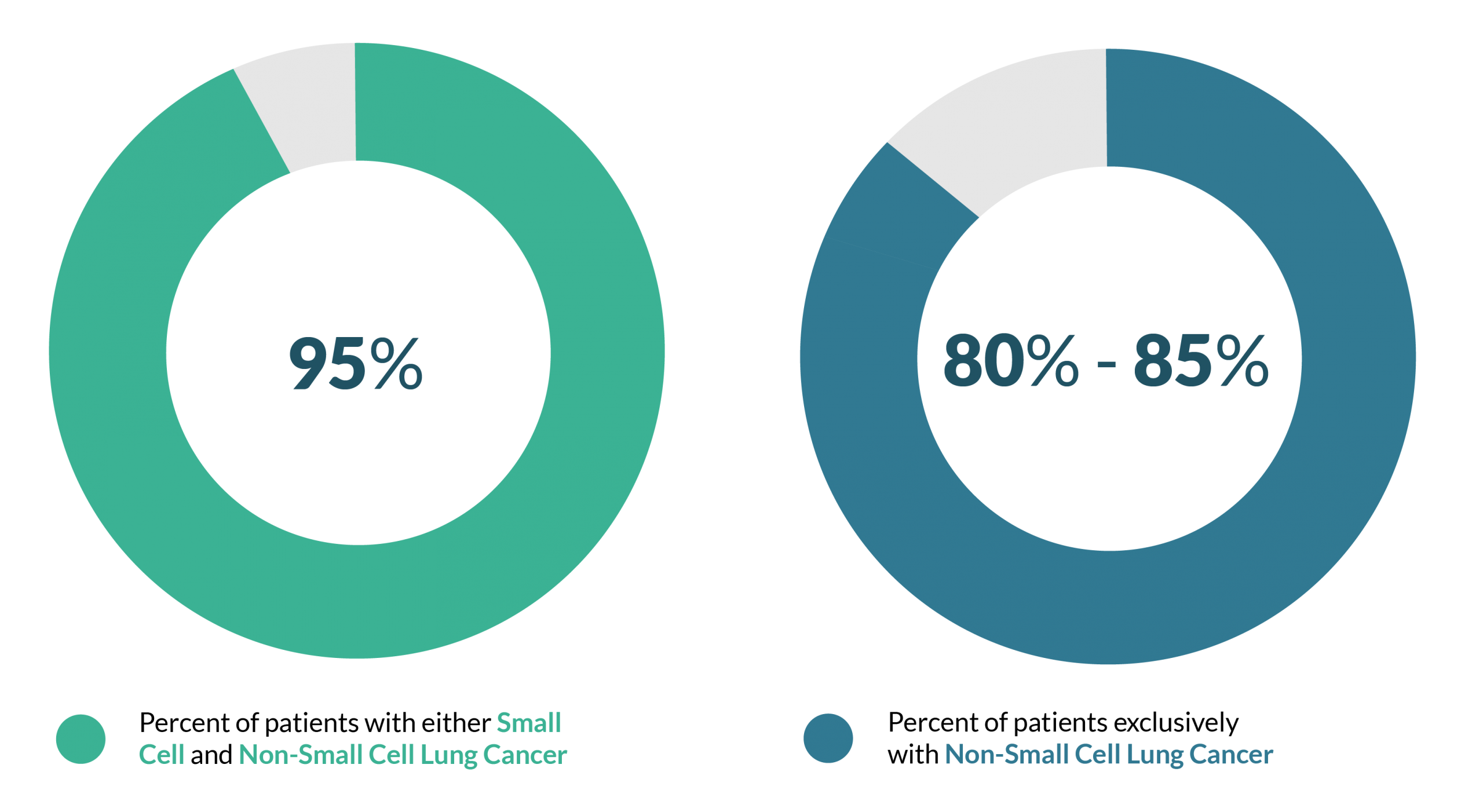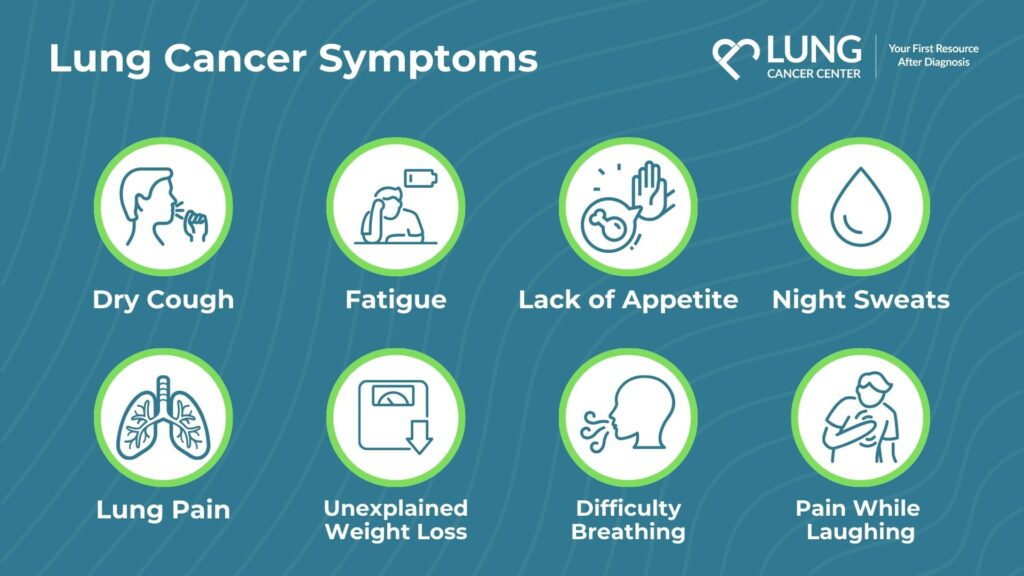Signs and Symptoms of Lung Cancer
Learn about the different symptoms of lung cancer and how each can affect you.

What Are the Symptoms of Lung Cancer?
Understanding the symptoms of a disease can help detect it earlier. Lung cancer often has symptoms that can be mistaken for less-fatal illnesses. At times, people do not realize anything is wrong until the disease is in its later, more aggressive stages. The most common early warning signs of lung cancer are:
- Fatigue
- Infection in the lungs (i.e., bronchitis, pneumonia)
- Lack of appetite
- Lung Pain
- Dry cough
- Persistent cough, occasionally with blood
- Night Sweats
- Persistent chest, back, and shoulder pain that worsens when coughing, breathing deeply, or laughing
- Shortness of breath during everyday activities
- Unexplained weight loss
- Hoarseness
- Smoker’s Cough
Advanced-Stage Symptoms
Typically, when lung cancer has advanced to a certain point, symptoms become more severe. Symptoms differ between people, however. Advanced stages of lung cancer, like stages 3 and 4, can cause the following issues:
- Bone pain
- Jaundice
- Lumps in the neck or collarbone area
- Swelling of the face, arms, or neck
Get the Help You Need
Symptoms of Non-Small Cell Lung Cancer
Usually, medical professionals group lung cancer into two main types, even though there are a few other types of NSCLC tumors (large cell, adenocarcinoma, squamous cell). This is because the two major types account for over 95 percent of patients. These two main types are known as small cell and non-small cell lung cancer and differ in how a doctor may treat them, as well as their tumor growth patterns. Non-small cell lung cancer (NSCLC) is the most common of the two types, making up for at least 80 percent to 85 percent of all lung cancer diagnoses.

NSCLC consists of three subtypes. These are adenocarcinoma, squamous cell carcinoma, and large cell carcinoma. Less common subtypes of NSCLC include adenosquamous and sarcomatoid carcinoma. Non-small cell lung cancer tends to grow slowly over time before symptoms are noticed. Those include:
- Bone pain
- Chronic coughing
- Fatigue
- Hemoptysis (cough that produces blood or red phlegm)
- Painful breathing
- Shortness of breath
- Dry cough
Symptoms of Small Cell Lung Cancer (SCLC)
Small cell lung cancer (SCLC) development is grouped into two stages: limited and extensive. These stages apply to all subtypes of SCLC (oat cell carcinoma). During the limited phase, tumors have only developed in one lung and possibly lymph nodes on one side of the chest. In the extensive stage (usually stage 3 and stage 4), tumors have metastasized from one lung to the other, as well as the lymph nodes and possibly even other organs.
Small cell lung cancer symptoms don’t develop until more progressed stages. Some signs of SCLC are:
- A persistent cough that can bring up blood
- Loss of appetite
- Shortness of breath
- Weight loss
- Dry cough
Symptoms in Other Areas of the Body
When lung cancer metastasizes (i.e., grows and spreads) to other parts of the body, it can cause issues and symptoms in those areas as well. Areas that can have metastasis:
- Lumps – If cancer makes it to the lymph nodes, tumors near the skin’s surface may look like lumps.
- Horner syndrome – When tumors cause nerve damage, symptoms could affect one side of the face. Droopy eyelids or pupil reduction may occur.
- Paraneoplastic syndrome – Sometimes, cancer can produce chemicals that force other reactions in particular areas of the body. This can evoke high blood calcium levels (hypercalcemia), blood clots, or excessive bone growth.
- Superior vena cava syndrome – Also known as SVC, the superior vena cava is a vein that moves blood from the head and arms to the heart. It also passes the upper part of the right lung and lymph nodes. Tumors can push on the SVC and cause blood to back up into the veins. In turn, this can generate swelling in the face, neck, arms, and upper chest. Other symptoms include a bluish skin color.
- Metastases – Sometimes, lung cancer can spread to the bones, liver, brain, or spinal cord.
- Bone – If cancer moves to the bones, then it can cause pain in the ribs or vertebrae. This can also cause fractures, constipation, and loss of ability to focus.
- Liver – When tumors make it to the liver, nausea, fatigue, swelling of the abdomen and hands, yellowing, or itchy skin can occur.
- Nervous System – Cancer spreading to either the brain or spinal cord may cause chronic headaches, blurred or double vision, speech issues, or seizures
Talk to a Doctor About Your Lung Cancer Symptoms
If you or someone you know have developed any symptoms mentioned, see a doctor immediately. They can analyze your situation and see if you are at risk for lung cancer due to smoking effects or other causes. If they determine there’s a risk, they will give you a screening. If the doctor detects lung cancer, they’ll give you their diagnosis, or formal medical analysis of your illness, a prognosis (survival rate), including treatment options and suggestions on how you may be able to improve your prognosis



